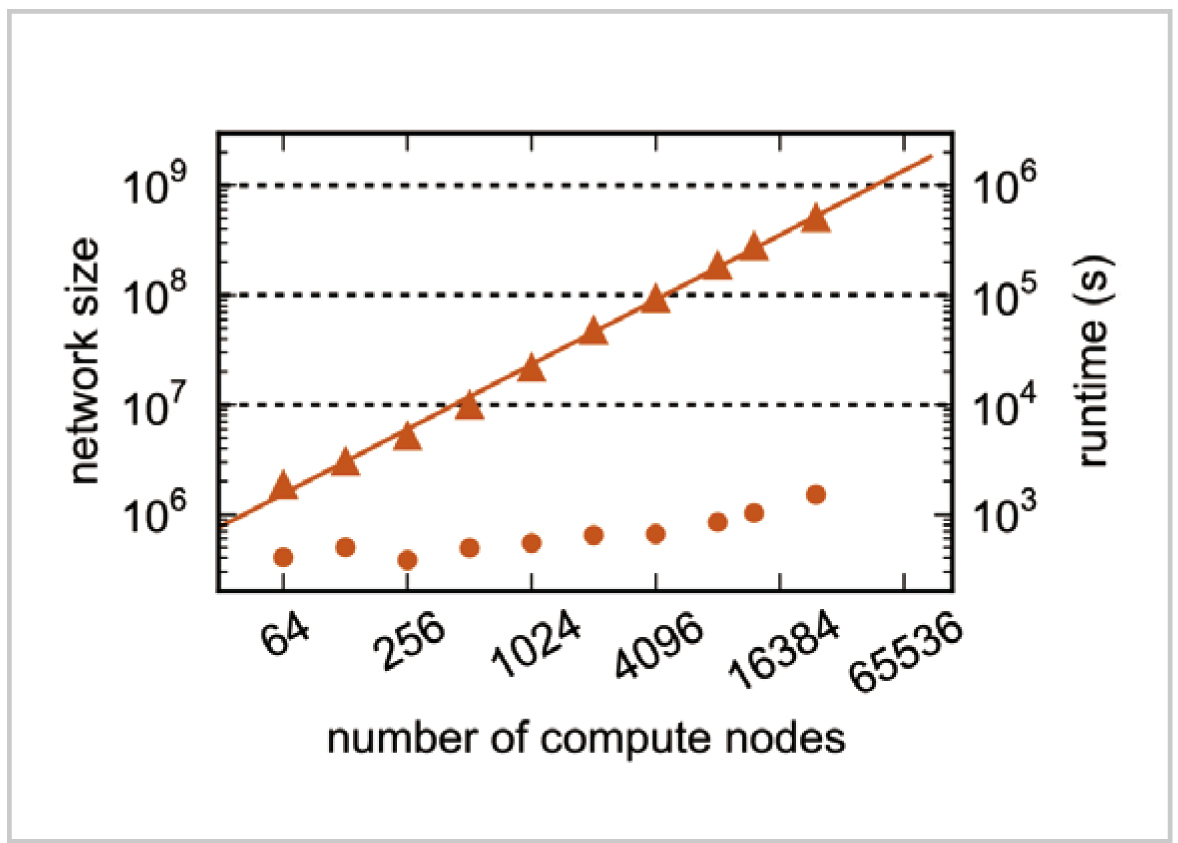
The road to brain-scale simulations on K

Brain Science Institute, RIKEN
Institute of Neuroscience and Medicine (INM-6), Juelich Research Center
Medical Faculty, RWTH Aachen University
Markus Diesmann
(Brain and Neural Systems WG)
This is the story of the endeavor of the Brain and Neural Systems Team (BNT) to make the computational power of K available to the field of computational neuroscience. An extended version of this report can be found at [1].
The human brain comprises about 1011 neurons, each connected to 10000 others. In computational neuroscience, the bottom-up approach often starts from a mathematical description of neurons and their interactions in order to investigate network dynamics [2]. The NEST simulator [3] is tailored to this resolution. Neurons are represented as small systems of differential equations, which interact by δ-impulses [4,5] to form networks of natural size and complexity.
The top-down approach starts from an abstract description of a particular brain function and investigates how this function is implemented at the neuronal level (e.g. [6]). The functional circuits of the brain typically involve several areas. Due to the demand of computer memory [7], however, simulations were previously constrained to the local microcircuit (e.g. [8,9]) or non-spiking macroscopic models. With supercomputers like K, the multi-scale connectivity of the brain is within reach.
At the time of the 1st BNT meeting (Nov 2008), NEST (2nd generation kernel, 2g) scaled to 1024 processors for 105 neurons. At the 3rd meeting (Oct 2009) the JUGENE computer at Juelich reached 106 neurons. By Feb 2010 we had set milestones for K with network size increasing from 106 to 108 and above. NEST compiled Nov 2010 on a prototype, May 2011 on the test system, and in Sep on K as reported on meetings 6 and 7.
In the 3g kernel, the data structures account for the sparseness of neurons with local targets and enable the efficient storage of information about non-local neurons [7]. At the 8th BNT meeting in Mar 2012, the second milestone came into sight, and was reached in May [10] utilizing just 12288 nodes of K. The upcoming NEST 2.2 release is based on this kernel.
The contacts between neurons exhibit different types of dynamics and plasticity [11,12]. In the limit where a neuron has either none or only a single synapse on a given compute core, however, this heterogeneity collapses to a single type. The 4g kernel presented at the 9th meeting in Sep 2012 exploits this uniqueness. The figure shows the maximum network size (triangles) for a given number of nodes and the runtime (dots). The 4g kernel enables simulations of 109 neurons on K. Neither kernel compromises on generality; functionality and user interface of NEST remain the same [13,14].
We hope that the simulation technology now available will help neuroscientists to integrate the data on the anatomy and dynamics of the brain into models to gain insights into brain function.
Our challenges ahead are to make the 4g technology available as a NEST release and to develop software concepts for the exa-scale machines now in preparation.
www.csn.fz-juelich.de
www.nest-initiative.org
Acknowledgements
Partly supported by early access to K at RIKEN AICS, Next-Generation Supercomputer Project of MEXT, Helmholtz Association: HASB and portfolio theme SMHB, JARA and EU Grant 269921 (BrainScaleS).
|
[References]
[1] Diesmann (2012) p83-85 In Proc 4th BioSupercomputing Symposium,Tokyo
[2] Lansner and Diesmann (2012) Chap 10 In Computational Systems Biology, Le Novere ed., Springer
[3] Gewaltig and Diesmann (2007) Scholarpedia 2(4):1430
[4] Morrison et al. (2008) Biol Cybern 98:459-78
[5] Hanuschkin et al. (2010) Front Neuroinform 4:113
[6] Potjans et al. (2011) PLoS Comput Biol 7(5): e1001133
[7] Kunkel et al. (2012) Front Neuroinform 5:35
[8] Potjans et al. (2012) Cerebral Cortex doi:10.1093/cercor/bhs358
[9] Wagatsuma et al. (2011) Front Comput Neurosci 5:31
[10] Helias et al. (2012) Front.Neuroinform 6:26
[11] Potjans et al. (2010) Front Comput Neurosci 4:141
[12] Pfeil et al. (2012) Front Neuromorph Eng 6:90
[13] Eppler et al. (2009) Front Neuroinform 2:12
[14] Gewaltig et al. (2012) Chap 18 In Computational Systems Biology, Le Novere ed., Springer
BioSupercomputing Newsletter Vol.8
- SPECIAL INTERVIEW
- Grand Challenge opens the way to the future of life science through innovative approach
Program Director, Computational Science Research Program, RIKEN
Koji Kaya - A Landmark Project that Brought on an Innovation in the Field of Life Scienc
Deputy-Program Director, Computational Science Research Program, RIKEN
Ryutaro Himeno
- Report on Research
- Multi-scale, multi-physics heart simulator UT-Hear
Graduate School of Frontier Sciences, the University of Tokyo
Toshiaki Hisada, Seiryo Sugiura, Takumi Washio,
Jun-ichi Okada, Akihito Takahashi
(Organ and Body Scale WG) - Simulation Model for Insulin Granule Kinetics in Pancreatic Beta Cells
Graduate School of System Informatics, Kobe University
Hisashi Tamaki(Cell Scale WG) - The road to brain-scale simulations on K
Brain Science Institute, RIKEN, Institute of
Neuroscience and Medicine (INM-6),
Juelich Research Center
Medical Faculty, RWTH Aachen University Markus Diesmann
(Brain and Neural Systems WG) - MD Core Program Development for Large-scale Parallelization
Computational Science Research Program, RIKEN
Yousuke Ohno(High-performance Computing Team)
- SPECIAL INTERVIEW
- Aiming to realize hierarchical integrated simulation in the circulatory organ system
and the musculoskeletal / cerebral nervous systems
Professor, Department of Mechanical Engineering and Department of Bioengineering The University of Tokyo
Shu Takagi(Theme3 GL) - Leading-edge large-scale sequence data analysis with K computer in order to promote the understanding of life programs and their diversity
Professor, Human Genome Center, The Institute of Medical Science, The University of Tokyo
Satoru Miyano(Theme4 GL)
- Report
- 4th Biosupercomputing Symposium Report
Computational Science Research Program, RIKEN
Eietsu Tamura - “K Computer” Compatible Computer: Installation of SCLS Computer System
HPCI Program for Computational Life Sciences, RIKEN
Yoshiyuki Kido

